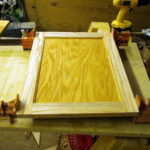Convenience should be your watchword when organizing a workshop. You’ll need to have plenty of storage space to keep tools and hardware out of the way when you’re working, but accessible when you need them. Adequate wiring and outlets are also a must.
It’s best to make a large, sturdy workbench the focus of your workshop. You have a choice of pre-made designs, or you can make your own from a 2×4 frame with a plywood or hardboard top. Ideally, the space beneath your workbench will provide room for drawers, cabinets, boxes, and shelves.
Grouping related tools and materials together makes them easy to find. Large power tools mounted on casters can be rolled out from a storage closet or cabinet, or away from a wall, then back again when the work is done. Wall cabinets best protect the blades and working parts of portable power tools from damage and keep them out of the reach of children.
Properly storing hand tools can be a challenge. The popular perforated hardboard and hanger system provides the best means for visible, hands-on storage. You can also buy individual wall racks for small tools such as screwdrivers and pliers. Though less accessible, closed units protect tools from rust and dust. A light oiling prevents tools from rusting.
Besides tools and projects in progress, you’ll want to store materials. Store leftovers in a rolling box with a hinged top. Shelf brackets fastened to every other wall stud will handle light lumber. Fiber storage tubes help protect lengths of pipe or moldings. For additional space, look to the rafters or ceiling joists.
Less-used storables, such as paint, brake fluid, and turpentine, can go on high shelves installed on the wall or suspended overhead or between ceiling joists. In an earthquake area, however, keep flammable liquids low – in a locked cabinet if there are children around. Size and space the shelves to fit the containers and make sure that their labels are visible.
Drawers are a blessing to any workshop owner. Build them into your work counters or in an open frame, or recycle old bedroom dressers or kitchen units. Drawers can hold a variety of small tools and supplies.
For hardware, you’ll want small jars, boxes, or bins to hold each type of nail, screw, and washer. Labeling the contents of each container makes for easy use.
TO make sure each tool goes back in its place on the wall, use silhouttes. The simples way to make silhouttes is to hang your tools in the ideal order and outline each one with a broad-tipped indelible felt pen. Or, lay each tool on heavy white paper and trace its outline. Then cut out the silhouette and glue it to the wall. The glued-on silhouttes will last longer if you apply a coat of clear sealer over them.
To organize tools in a drawer and protect their edges, cut a series of wood blocks and screw them to the drawer bottom from underneath. Cut the blocks so a portion of the tool blades will be visible and space them to fit the blades.



